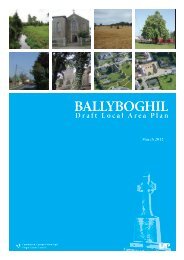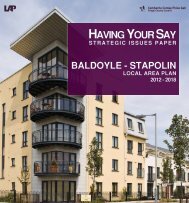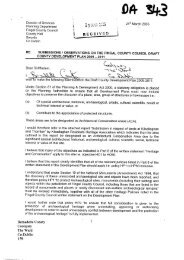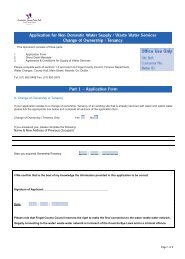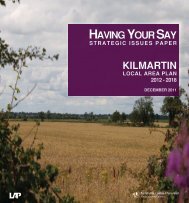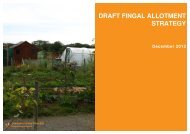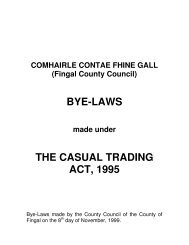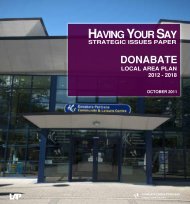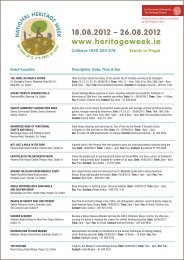Donabate Urban Centre Strategy Fingal County Council
Donabate Urban Centre Strategy Fingal County Council
Donabate Urban Centre Strategy Fingal County Council
You also want an ePaper? Increase the reach of your titles
YUMPU automatically turns print PDFs into web optimized ePapers that Google loves.
4.0 Character Assessment<br />
4.1 Character Areas<br />
<strong>Donabate</strong> town contains fairly distinctive ‘character areas’ – these are<br />
parts of the town, which are distinctive in their own right or vary<br />
from other parts of town. Four character areas have been identified in<br />
<strong>Donabate</strong> town. Please refer to Map 3: Character Areas.<br />
4.1.1 Along Main Street<br />
Main Street as a whole forms the main commercial/retail area of<br />
<strong>Donabate</strong> Town and as such development has followed the linear<br />
structure of the main access route through the town. Main Street is<br />
composed of a number of modern buildings dating from the late 1980’s/<br />
early 1990’s. Interspersed amongst these are older style detached<br />
properties dating from the late 19th century. Land use in this area<br />
includes a mix of commercial (retail and services), civic (church) and<br />
residential. Density varies depending on the land use. Site coverage is<br />
generally high on the commercial properties, low on the civic (church)<br />
property and variable on the residential properties.<br />
The shape and size of the plots are differing, depending on their use.<br />
Plot widths range on average from 21m to 61m in width on the eastern<br />
side of the Main Street. On the western side this varies between 25m<br />
to 77m. Plot depths vary considerably between both sides of the Main<br />
Street. On average plot depths range from 55m to 80m on the western<br />
side and 27m to 80 metres on the eastern side of the Main Street.<br />
The commercial buildings fronting the street generally comprise shops<br />
on the ground floor,with offices or restaurants on the upper floor (none<br />
of the buildings are more than two storeys). Recent developments have<br />
established a strong building line on the street. There is no uniformity<br />
in the architectural style or materials of the commercial buildings, and<br />
the same is true for the recent residential developments. The one<br />
material that is common to both commercial and residential buildings<br />
is red brick. This is in reference to the church, the focal point of the<br />
town centre and the town’s principal landmark. The distinctive red<br />
Portmarnock brick of which it is built is characteristic of the civic<br />
buildings of <strong>Donabate</strong> and the environs. The same (or similar) brick is<br />
used in the old school building at Portrane Road and St. Ita’s Hospital.<br />
Focal buildings of note along the Main Street include Saint Patrick’s<br />
Roman Catholic Church and Warington’s House.<br />
Saint Patrick’s Roman Catholic Church is a detached gable-fronted<br />
cruciform plan Roman Catholic church built in 1903, with a tower<br />
to the right-hand side. The roof is double pitched of clay tiles and<br />
terracotta ridge tiles with cast-iron rainwater goods. The walls are<br />
constructed of red brick with decorative buttressing. The openings of<br />
the church consist of pointed arched doors with limestone surrounds<br />
and tongue and grooved timber doors with cast-iron hinges. The front<br />
elevation has an ornate rose window with lancet windows, limestone<br />
surrounds and stained glass.<br />
Warington’s House is a detached four-bay two-storey house, c.1860,<br />
with projecting entrance porch and original fenestration. The roof<br />
consists of a double-pitched slate roof with terracotta ridge tiles,<br />
two brick chimney stacks with terracotta pots. The walls are coursed<br />
rubble stone with tooled limestone quoining. The openings consist of<br />
rusticated limestone dressed window openings, granite cills and timber<br />
sash windows.<br />
In recent years, the area has experienced some significant development<br />
of the backland areas - specifically on the western side of Main<br />
Street, between it and the railway line. The emerging pattern is one<br />
of freestanding blocks of 3-4 storeys surrounded by areas of surface<br />
parking and open space. There may be opportunities for creating a new<br />
street network in the area.<br />
View of Saint Patrick’s Roman Catholic Church<br />
View of Warington’s House<br />
<strong>Donabate</strong> <strong>Urban</strong> <strong>Centre</strong> <strong>Strategy</strong> 9




